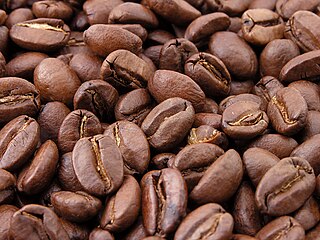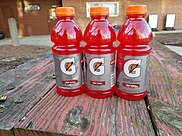
Caffeine is a central nervous system (CNS) stimulant of the methylxanthine class. It is mainly used as a eugeroic (wakefulness promoter) or as a mild cognitive enhancer to increase alertness and attentional performance. Caffeine acts by blocking binding of adenosine to the adenosine A1 receptor, which enhances release of the neurotransmitter acetylcholine. Caffeine has a three-dimensional structure similar to that of adenosine, which allows it to bind and block its receptors. Caffeine also increases cyclic AMP levels through nonselective inhibition of phosphodiesterase.

Red Bull is a brand of energy drinks created and owned by the Austrian company Red Bull GmbH. With a market share of 43%, it is the most popular energy drink brand as of 2020, and the third most valuable soft drink brand, behind Coca-Cola and Pepsi. Sinсe its launch in 1987, more than 100 billion cans of Red Bull have been sold worldwide, including over 12 billion in 2023.

Chocolate milk is a type of flavoured milk made by mixing cocoa solids with milk. It is a food pairing in which the milk's mouthfeel masks the dietary fibres of the cocoa solids.

Gatorade is an American brand of sports-themed beverage and food products, built around its signature line of sports drinks. Gatorade is currently manufactured by PepsiCo and is distributed in over 80 countries. The beverage was first developed in 1965 by a team of researchers led by Dr. Robert Cade. It was originally made for the Gators at the University of Florida to replenish the carbohydrates that the school's student-athletes burned and the combination of water and electrolytes that they lost in sweat during vigorous sports activities.

An energy drink is a type of drink containing stimulant compounds, usually caffeine, which is marketed as providing mental and physical stimulation. They may or may not be carbonated and may also contain sugar, other sweeteners, or herbal extracts, among numerous other possible ingredients.
Lucozade is a British brand of soft drinks and energy drinks manufactured and marketed by the Japanese company Suntory. Created as "Glucozade" in the UK in 1927 by a Newcastle pharmacist, William Walker Hunter, it was acquired by the British pharmaceutical company Beecham's in 1938 and sold as Lucozade, an energy drink for the sick. Its advertising slogan was "Lucozade aids recovery". It was sold mostly in pharmacies up until the 1980s before it was more readily available as a sports drink in shops across the UK.

Maltodextrin is a name shared by two different families of chemicals. Both families are glucose polymers, but have little chemical or nutritional similarity.

Powerade is a sports drink created and sold by the Coca-Cola Company. Its primary competitor is Gatorade, owned by PepsiCo.
Bodybuilding supplements are dietary supplements commonly used by those involved in bodybuilding, weightlifting, mixed martial arts, and athletics for the purpose of facilitating an increase in lean body mass. Bodybuilding supplements may contain ingredients that are advertised to increase a person's muscle, body weight, athletic performance, and decrease a person's percent body fat for desired muscle definition. Among the most widely used are high protein drinks, pre-workout blends, branched-chain amino acids (BCAA), glutamine, arginine, essential fatty acids, creatine, HMB, whey protein, ZMA, and weight loss products. Supplements are sold either as single ingredient preparations or in the form of "stacks" – proprietary blends of various supplements marketed as offering synergistic advantages.

Isomaltulose is a disaccharide carbohydrate composed of glucose and fructose. It is naturally present in honey and sugarcane extracts and is also produced industrially from table sugar (sucrose) and used as a sugar alternative.

Sports nutrition is the study and practice of nutrition and diet with regards to improving anyone's athletic performance. Nutrition is an important part of many sports training regimens, being popular in strength sports and endurance sports. Sports nutrition focuses its studies on the type, as well as the quantity of fluids and food taken by an athlete. In addition, it deals with the consumption of nutrients such as vitamins, minerals, supplements and organic substances that include carbohydrates, proteins and fats.
Running economy (RE) a complex, multifactorial concept that represents the sum of metabolic, cardiorespiratory, biomechanical and neuromuscular efficiency during running. Oxygen consumption (VO2) is the most commonly used method for measuring running economy, as the exchange of gases in the body, specifically oxygen and carbon dioxide, closely reflects energy metabolism. Those who are able to consume less oxygen while running at a given velocity are said to have a better running economy. However, straightforward oxygen usage does not account for whether the body is metabolising lipids or carbohydrates, which produce different amounts of energy per unit of oxygen; as such, accurate measurements of running economy must use O2 and CO2 data to estimate the calorific content of the substrate that the oxygen is being used to respire.
A functional beverage is a conventional liquid food marketed to highlight specific product ingredients or supposed health benefit.

Energy gels are edible carbohydrate gels that provide energy for exercise and promote recovery, commonly used in endurance events such as running, cycling, and triathlons. Energy gels are also referred to as endurance gels, sports gels, nutritional gels, and carbohydrate gels.

Protein bars are a convenience food that contains a high proportion of protein relative to carbohydrates and fats. Despite the label focusing on protein, many mass-marketed protein bars contain more added sugar than some desserts like cookies or doughnuts.

Added sugars or free sugars are sugar carbohydrates added to food and beverages at some point before their consumption. These include added carbohydrates, and more broadly, sugars naturally present in honey, syrup, fruit juices and fruit juice concentrates. They can take multiple chemical forms, including sucrose, glucose (dextrose), and fructose.

Sugar-sweetened beverages (SSB) are any beverage with added sugar. They have been described as "liquid candy". Consumption of sugar-sweetened beverages have been linked to weight gain and an increased risk of cardiovascular disease mortality. According to the CDC, consumption of sweetened beverages is also associated with unhealthy behaviors like smoking, not getting enough sleep and exercise, and eating fast food often and not enough fruits regularly.
Central nervous system fatigue, or central fatigue, is a form of fatigue that is associated with changes in the synaptic concentration of neurotransmitters within the central nervous system which affects exercise performance and muscle function and cannot be explained by peripheral factors that affect muscle function. In healthy individuals, central fatigue can occur from prolonged exercise and is associated with neurochemical changes in the brain, involving serotonin (5-HT), noradrenaline, and dopamine. The roles of dopamine, noradrenaline, and serotonin in CNS fatigue are unclear, as pharmacological manipulation of these systems has yielded mixed results. Central fatigue plays an important role in endurance sports and also highlights the importance of proper nutrition in endurance athletes.
Pre-workout is a generic term for a range of bodybuilding supplement products used by athletes and weightlifters to enhance athletic performance. Supplements are taken to increase endurance, energy, and focus during a workout. Pre-workout supplements contain a variety of ingredients such as caffeine and creatine, differing by capsule or powder products. The first pre-workout product entered the market in 1982, and since then the category has grown in use. Some pre-workout products contain ingredients linked to adverse effects. Although these products are not regulated, the Food and Drug Administration (FDA) warns consumers to be cautious when consuming them.

Caffeine use for sport is a worldwide known and tested idea. Many athletes use caffeine as a legal performance enhancer, as the benefits it provides, both physically and cognitively outweigh the disadvantages. The benefits caffeine provides influences the performance of both endurance athletes and anaerobic athletes. Caffeine has been proven to be effective in enhancing performance.

















